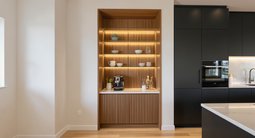TL;DR
Buyers are mixing Costco, IKEA, Amazon, HomeGoods, and secondhand finds to stretch budgets and speed setup. For sellers and agents, smart home staging and realistic listing visuals now matter more than ever, especially when buyers expect durable pieces without designer prices.
The New Home Goods Playbook

An entryway blending secondhand and new home goods illustrates the practical styling shaping home staging today.
SEO intro: Americans are furnishing homes with a mix of big box, online, and secondhand. Here is where they shop and how it shapes home staging.
Where Americans Really Buy Home Goods Now: What It Means for Home Staging and Real Estate Marketing
Tight budgets, fast move-ins, and quality concerns are reshaping how people furnish their homes and how agents should stage listings.
Home staging and real estate marketing live or die on trust, and home goods are the proof. With household furnishings prices up roughly 15 to 20 percent since 2020, according to consumer price trend trackers, Americans are shopping across Costco, IKEA, Walmart, Target, Amazon, HomeGoods, Wayfair, and a growing secondhand ecosystem to make rooms feel complete. Agents say buyers expect realistic listing visuals that look like how people actually live, not styled sets that vanish at closing. That shift changes how to stage, photograph, and position a property today.
National Data Insight
Home staging is most effective when it mirrors how buyers furnish in real life. Industry surveys consistently find that about 80 percent of buyers' agents say staging helps clients visualize a property, and many sellers' agents report a 1 to 5 percent price lift when presentation is done right. Homes with strong listing visuals and clear design intent also tend to attract more clicks and showings in the first 72 hours, which is when most interest is won or lost.
Here is what Americans are doing: they are splitting purchases between big-box reliability, fast online delivery, and secondhand value. Warehouse clubs cover sofas, sectionals, and dining sets that ship quickly. IKEA fills gaps with modular storage and small-space solutions. Discount chains and off-price home stores supply rugs, mirrors, and seasonal decor for up to 30 to 60 percent less than department store tags, according to buyers who compare receipts. Secondhand and estate sales cover solid wood case goods that last. A realistic bar chart of a typical furnishing plan today would show three nearly equal pillars: big box, online marketplaces, and gently used.
Agents often advise investing staging budget into a few hero items that anchor photos: a quality sofa, an inviting bed, and two to three large-scale lamps. Those pieces do the heaviest lifting in property photos and virtual tours, and they set expectations for scale. Alt text idea for the lead image in your listing: bright living room with a simple linen sofa, natural wood coffee table, and textured rug that reads warm and attainable.
Anecdote
A wildfire survivor rebuilt a three-bedroom home’s look for about 40 percent of typical retail by sourcing estate-sale dining chairs, a consignment credenza, and an outlet sofa, then cleaned rugs professionally. The rooms photographed beautifully, and the family says nothing feels precious, which is exactly how buyers want to live after closing.
Regional and Segment Patterns
Real estate marketing performs best when it nods to local shopping patterns. In the Midwest and Mountain states, home improvement chains and regional furniture giants with 10 to 11 percent rebate programs draw value-driven buyers. Solid-wood consignment in established suburbs remains a goldmine, and buyers like to brag when a $200 vintage dresser outlives a $600 flat-pack.
Coastal metros skew design-forward but practical. Shoppers blend Crate & Barrel, Room & Board, and CB2 with estate-sale statement pieces and marketplace steals. In the Sun Belt, warehouse clubs and large-format furniture stores dominate because of stock depth and weekend delivery. Urban renters lean on IKEA for closet systems and office setups that can move apartment to apartment. Rural and college towns rely on Facebook Marketplace and local auctions, where prices can be 40 to 70 percent below retail and pickup is same day.
Florida agents point out that insurance and humidity push buyers toward leather sectionals and performance fabrics. Pacific Northwest buyers love consignment for teak and mid-century silhouettes. Northeast buyers report quick-turn options like regional discount furniture chains for beds and nightstands that must arrive before the first Monday in a new lease. The through-line is speed, value, and the feeling that a piece can survive a second move.
Behavior and Market Psychology
Home staging works because it lowers cognitive load for buyers who are juggling rates, closing costs, and delivery timeframes. After paying thousands to move, people hunt for pieces that do not off-gas, do not wobble, and can be cleaned fast. Designers often note that particle board fatigue is real. Many buyers have tossed a cheap bookcase and now look for solid wood, steel frames, or recycled stone that can be repaired.
I have seen this play out in three very different stories. A Phoenix couple who lost belongings in a wildfire rebuilt their space almost entirely from estate sales and local auctions. The result was timeless, heavy, and surprisingly affordable, about 60 percent less than buying new. A Queens renter, facing a tight timeline, used a regional discount chain for a bed and nightstand delivered before move-in day. The set was not luxurious, but it got them sleeping on night one. In the suburbs, a homeowner pointed to a 20-year-old Crate & Barrel sofa that still looks presentable in listing photos. That long-term durability is exactly the story buyers want to believe when they tour.
Market analysts suggest that this mix of urgency and durability is why pragmatic staging resonates. People do not want to see a fantasy. They want a believable path to living well in the space within 30 days of closing, on a budget that still leaves room for a rate buydown or closing credit.
When and How Furnishing Decisions Tip the Deal
Most real estate listing strategies rise or fall during the first week, and most furnishing decisions happen in the first month after move-in. Buyers allocate the largest share of their budget to the sofa and mattress, often 40 to 60 percent of early spend, according to retailers. The rest goes to rugs, lamps, and storage that make photos and daily life work. That is why agents recommend staging that emphasizes those anchors, then keeps secondary decor simple and honest.
Kitchen and bath purchases follow clear lanes. Big-box and warehouse stores cover faucets, vanities, and shower systems in stock, while specialty showrooms serve higher-end remodels with longer lead times, often 6 to 12 weeks. Restaurant supply stores provide unbranded cookware and glasses that are tough, stackable, and consistent to replace. For appliances, buyers choose retailers with next-day haul-away and extended warranties, even if list price is slightly higher, because a failed fridge is a deal breaker.
Secondary insights matter: most contract wobbles show up at the inspection and appraisal step. If presentation promises a move-in-ready feel but buyers discover peeling veneer, broken drawers, or yellowed silicone around fixtures, trust cracks. Experts advise pre-list touchups that cost under 1 percent of list price but remove those friction points. Simple upgrades like bright LED bulbs, a neutral 8 by 10 rug, and two matching bedside lamps can warm photos and reduce buyer anxiety immediately. Homes with virtual staging sell faster when scenes stay true to scale, and agents who tested it say realistic virtual staging can cut time on market by weeks in slower price bands.
Visualization Scenario
Visualization note: a simple clustered bar chart showing equal reliance on big-box, online, and secondhand sources would illustrate the modern furnishing mix. Caption idea: three paths to a furnished home in 30 days. Alt text idea: chart comparing shares of big-box, online, and secondhand purchases for home goods.
FAQ
- Where should I buy home staging furniture on a budget for real estate marketing?
For home staging on a budget, mix IKEA storage, Costco or Target sofas, and secondhand solid-wood pieces; this real estate marketing approach creates realistic listing visuals at low cost. - Is secondhand furniture good for home staging and how do I keep it buyer friendly?
Secondhand furniture is great for home staging if it is structurally sound; choose neutral fabrics, clean professionally, and avoid odors or heavy wear to keep listing visuals buyer friendly. - What are the best home improvements before selling that boost value without overspending?
The best home improvements before selling are paint, lighting, minor bath fixes, and simple staging; agents often see a 1 to 5 percent price lift for clean, neutral presentation. - How should I market real estate listings online with virtual staging so buyers trust the photos?
For virtual staging of real estate listings online, keep furniture to true scale, use attainable brands, and match the home’s light and sightlines so buyers recognize the space at showings. - What decor helps attract millennial homebuyers without breaking the staging budget?
To attract millennial homebuyers, use warm neutrals, layered lighting, a simple wood coffee table, and plants; these affordable home staging choices photograph well and feel livable.
Market Outlook and Reflection
Real estate marketing is moving toward practical aspiration. Buyers want attainable design, flexible storage, and sturdy materials that feel familiar from the stores they already use. Expect secondhand to remain strong as consignment quality beats many flat-pack options on price and durability. Expect buyers to reward listings that look honest about scale and layout, not staged within an inch of reality.
Trust is the rarest currency in a cautious market. Stage for how people furnish today, and you will earn it. Tools like ReimagineHome help agents and homeowners visualize spaces, test realistic design options, and preempt buyer hesitation with clear, credible listing visuals before you ever schedule photos.
.svg)

.svg)









.png)